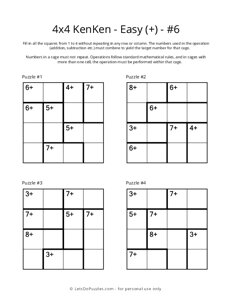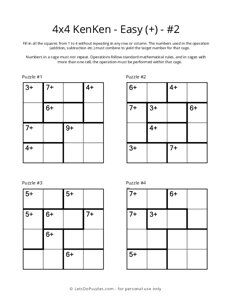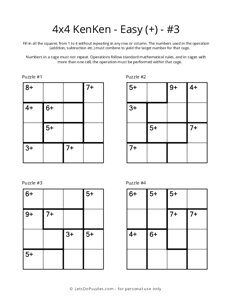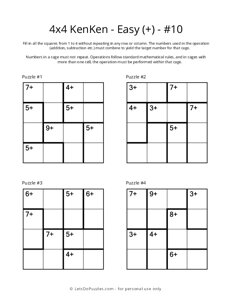KenKen Puzzles
Kendoku is a numerical puzzle game similar to Sudoku but with a few key differences. It's also known by other names like Mathdoku, Calcudoku, or KenKen. The goal of Kendoku is to fill a grid with numbers according to certain rules.
Recommended: Check out our Printable Puzzle Books Collection to download and print.
Also try these puzzle makers to make your own custom printable puzzles.
Need Help? To get started, check out these instructions, goals and rules for how to solve puzzles
Select a section to filter results:
 4x4 KenKen - Easy (+) - 5
4x4 KenKen - Easy (+) - 5 4x4 KenKen - Easy (+) - 8
4x4 KenKen - Easy (+) - 8 4x4 KenKen - Easy (+) - 9
4x4 KenKen - Easy (+) - 9 4x4 KenKen - Easy (+) - 4
4x4 KenKen - Easy (+) - 4 4x4 KenKen - Easy (+) - 7
4x4 KenKen - Easy (+) - 7 4x4 KenKen - Easy (+) - 1
4x4 KenKen - Easy (+) - 1 4x4 KenKen - Easy (+) - 6
4x4 KenKen - Easy (+) - 6 4x4 KenKen - Easy (+) - 2
4x4 KenKen - Easy (+) - 2 4x4 KenKen - Easy (+) - 3
4x4 KenKen - Easy (+) - 3 4x4 KenKen - Easy (+) - 10
4x4 KenKen - Easy (+) - 10
Key features of Kendoku:
- Grid Structure: The grid in Kendoku can vary in size but is usually a square. The most common sizes are 4x4, 6x6, 8x8, and 9x9.
- Number Placement: Instead of filling the grid with numbers from 1 to 9 (as in Sudoku), Kendoku puzzles involve using specific numbers and mathematical operations within a set of cages.
- Cages: Kendoku grids are divided into cages, and each cage has a target number and an operation. For example, a cage might contain three squares and have a target number of 6, with the operation being multiplication. This means the three numbers within that cage should multiply to give 6.
- Mathematical Operations: The operations used in Kendoku include addition, subtraction, multiplication, and division. Each cage's target number must be achieved using the given operation and the numbers within the cage, following standard mathematical rules.
- No Repeating Numbers: Like Sudoku, numbers cannot be repeated within the same row or column.
- Logical Deduction: Solving Kendoku puzzles requires logical deduction, considering the relationships between cages and their target numbers, along with the constraints of row and column placements.
To solve a Kendoku puzzle, you need to use deduction and logic to fill in the grid with the correct numbers based on the given constraints. Each puzzle has a unique solution that can be reached through reasoning and elimination.
Kendoku puzzles come in various difficulty levels, with some grids having a few numbers pre-filled to provide initial clues and others being entirely blank, requiring more advanced problem-solving skills to solve.
